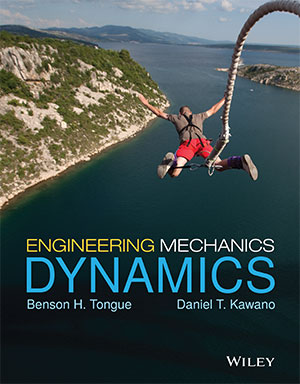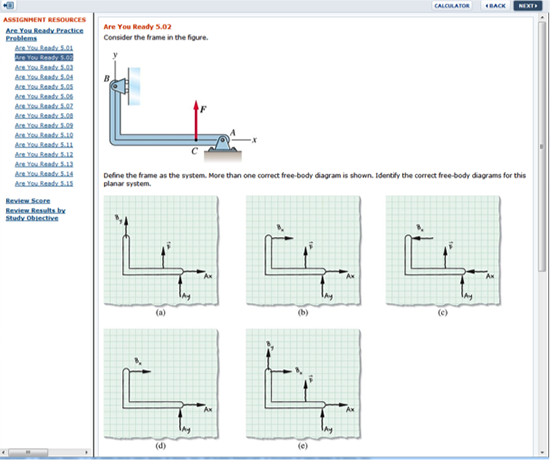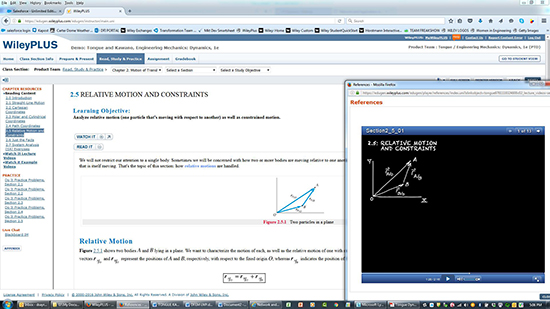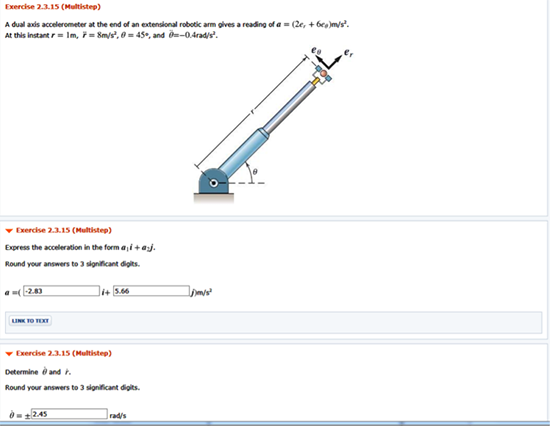
Engineering Mechanics: Dynamics
By Benson H. Tongue and Daniel T. Kawano
Engineering Mechanics: Dynamics is an online learning system designed to address the key learning and teaching issues in today’s engineering mechanics courses. Built for a digital environment, it includes powerful and customizable resources to facilitate mastery of introductory dynamics concepts for students with a wide range of abilities and backgrounds.
WileyPLUS with ORION for Engineering Mechanics gives you and your students clear visibility into areas of strengths and weaknesses so that you can use this information to build a learning path to success together.
Schedule a Demo Sign Up for a Test Drive Adopt WileyPLUSWant to learn more about WileyPLUS? Click Here
Adaptive learning gives students the practice they need for concept mastery.
ORION Adaptive Practice helps students build their proficiency on important prerequisite math and physics topics and use their study time most effectively.

Diagnostic assessment prepares students for each new concept.
Brief diagnostic quizzes let students gauge their readiness for each new chapter and the areas they need to review further.

Instructional cadence of “tell, show, do” is applied throughout.
For each new major concept within a chapter, students will read or watch a passage that develops the concept followed by solved examples that apply it. Students then get a chance to master the concept through progressive, interactive exercises.

Scaffolded learning
Practice exercises and a selection of homework problems will use techniques such as hints, partial solutions, feedback on common mistakes, and progressive complexity to build student confidence and reinforce skills.

Optional pathways and resources
This course supports differences in students’ ideal learning styles. For example, they will be able to choose a preferred pathway through the conceptual and example content: video, textual, or a mixture of both. All practice exercises will be available to students for self-study, even if they are not formally assigned by instructors for assessment.
- ORION FOUNDATIONS:
An adaptive practice system that helps students build their proficiency on important prerequisite math and physics topics and use their study time most effectively. - Diagnostic assessment before each new chapter:
Students can gauge their readiness for each new chapter—and what they may need to review further—with a brief diagnostic quiz. - A consistent instructional cadence of tell, show, do:
For each new major concept within a chapter, students will read or watch a passage that develops it, then see solved examples that apply it, and finally have an opportunity to master it through progressive, interactive exercises. - Scaffolded learning:
Practice exercises and a selection of homework problems will use techniques such as hints, partial solutions, feedback on common mistakes, and progressive complexity to build student confidence and reinforce skills. - Optional pathways and resources:
The course supports differences in students’ ideal learning styles. For example, they will be able to choose a preferred pathway through the conceptual and example content: video, textual, or a mixture of both. All practice exercises will be available to students for self-study, even if they are not formally assigned by instructors for assessment. - The text website, www.wiley.com/college/tongue, includes answers to selected exercises from the text to help students check that they have solved the exercises correctly.
- MATLAB M-files used in certain examples are available for download from the text website.
- Animations and simulations, including lecture and example videos, that enhance visualization skills and allow “what if” analysis is available in WileyPLUS.
- Solutions manual: Typed solutions to all exercises, using the same solution procedure as the worked examples.
- Electronic figures: All figures from the text are available electronically, for use in creating your own lectures.
What’s New
WileyPLUS is an online teaching and learning platform that helps you and your students achieve educational success. WileyPLUS gives students opportunities for practice, organizes learning to show connections between assessment and learning content, and tracks progress to help students stay on path for success. Each element of the online experience has been crafted to form part of a cohesive learning experience that leverages the unique capabilities available in a digital setting. To address student learning and mastery challenges, Engineering Mechanics: Dynamics provides:
Additional student resources
Additional instructor resources

Benson Tongue is Professor Emeritus of Mechanical Engineering at the University of California at Berkeley.
Hear Benson Tongue describe the inspiration for developing this course and how it can help you drive your student engagement and success.

Daniel Kawano is Assistant Professor, Department of Mechanical Engineering, at Rose-Hulman Institute of Technology.
Chapter 1: Background and Roadmap
Chapter 2: Motion of Translating Bodies
Chapter 3: Inertial Response of Translating Bodies
Chapter 4: Energetics of Translating Bodies
Chapter 5: Multi-body Systems
Chapter 6: Kinematics of Rigid Bodies Undergoing Planar Motion
Chapter 7: Kinetics of Rigid Bodies Undergoing Two-Dimensional Motion
Chapter 8: Kinematics and Kinetics of Rigid Bodies in Three-Dimensional Motion
Chapter 9: Vibratory Motions

